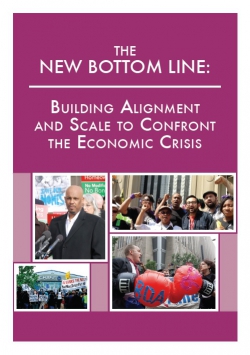Feb
25
2014

Over the last few years, there’s been growing interest in – and analysis of – alliances. From the 2010 report by Manuel Pastor that Frances looked back at last week, to the current issue of the Stanford Social Innovation Review, more and more thought leaders are exploring collaboration between organizations as a key strategy for movement building. We are very excited to add to the growing body of research evaluating alliances with our latest report – The New Bottom Line: Building Alignment and Scale to Confront the Economic Crisis.
The New Bottom Line was formed by four national organizing networks – the Alliance for a Just Society, National People’s Action, PICO National Network and Right to the City. Even though the organizing sector has been moving towards greater collaboration and coordination over the last decade, there is also a long history of fragmentation between organizing groups. Whereas a generation ago, distinct organizing networks would be pitted against each other over things like “turf” or “leadership,” the four networks that formed NBL created an alliance where their unique organizing traditions and bases complemented each other. They also built campaign structures that coordinated the work of the four networks, but allowed for enough flexibility for individual groups to take the lead. And while the NBL leaders were focused on changing the policies and practices of the banks that had crashed the economy – and they did win major concrete policy wins – they never lost sight of the long-term goal of building relationships that would last for future fights.
Their mix of near-term strategy and long-term vision is part of why NBL didn’t just move a traditional campaign; they contributed to a movement moment. NBL formed in 2010 and focused public scrutiny and direct action on the banks, but they were part of a wave of action around economic inequality. When historians look back on the current era’s movement energy and action to address the struggles of the millions on the losing end of the economic “recovery,” NBL will be part of the story – along with Occupy Wall Street, striking fast food workers, and the President’s call to raise the minimum wage.
Sure, NBL had some setbacks – campaign plans didn’t always work out and relationships could sometimes be strained – but we learn from both what works and what doesn’t. So the example of NBL, in all its complexity, holds many lessons for progressive groups looking to build strong alliances and movements for change. Specifically, we identify the following five lessons in the report:
- Hold vision and action together
- Create structures that foster trust and respect, anticipating conflict
- Fund the alliance and the base
- Don’t just aggregate, augment
- Build connections at all levels
These are things that all alliances have to figure out, and we hope that the evaluation of the New Bottom Line informs and supports emerging alliances to also contribute to the current movement moment; because, in 2014, more alliances (and even alliances of alliances) will be needed to build a movement for economic and racial justice.
